Experimental and Numerical Determination of the Mechanical Properties of Spruce Wood
Abstract
1. Introduction
2. Materials and Methods
2.1. Materials and Equipment
2.2. Computational Model
2.2.1. Geometry
2.2.2. Material Model
2.2.3. Boundary Conditions
3. Results and Discussion
3.1. Experimental Results
3.2. Comparison between Computational and Experimental Results
4. Conclusions
Author Contributions
Funding
Conflicts of Interest
References
- Smith, I.; Landis, E.; Gong, M. Fracture and Fatigue in Wood; John Wiley & Sons Ltd.: Hoboken, NJ, USA, 2003. [Google Scholar]
- Bowyer, J.; Bratkovicg, S.; Fernholz, K.; Frank, M.; Hanessian, S.; Groot, H.; Pepke, E. Modern Tall Wood Buildings: Opportunities for Innovation; Dovetail Partners Inc.: Minneapolis, MN, USA, 2016. [Google Scholar]
- Clouston, P.; Bathon, L.; Schreyer, A. Shear and Bending Performance of a Novel Wood–Concrete Composite System. J. Struct. Eng. 2005, 131, 1404–1412. [Google Scholar] [CrossRef]
- Mahapatra, K.; Gustavsson, L. General Conditions for Construction of Multi-Storey Wooden Buildings in Western Europe; Vaxjo University, School of Technology and Design: Smorland, Sweden, 2009. [Google Scholar]
- Goodman, J.R.; Bodig, J. Mathematical model of the tension behavior of wood with knots and cross grain. In Proceedings of the first International Conference on Wood Fracture, Banff, Alberta, 14–16 August 1978. [Google Scholar]
- Zandbergs, J.G.; Smith, F.W. Finite-Element Fracture Prediction for Wood with Knots and Cross Grain. Wood Fiber Sci. 1988, 20, 97–106. [Google Scholar]
- Hackspiel, C.; de Borst, K.; Lukacevic, M. A numerical simulation tool for wood grading: Model validation and parameter studies. Wood Sci. Technol. 2014, 48, 651–669. [Google Scholar] [CrossRef]
- Lukacevic, M.; Fussl, J.; Griessner, M.; Eberhardsteiner, J. Performance Assessment of a Numerical Simulation Tool for Wooden Boards with Knots by Means of Full-Field Deformation Measurements. Strain 2014, 50, 301–317. [Google Scholar] [CrossRef]
- Guindos, P.; Guaita, M. A three-dimensional wood material model to simulate the behavior of wood with any type of knot at the macro-scale. Wood Sci. Technol. 2013, 47, 585–599. [Google Scholar] [CrossRef]
- Olsson, A.; Oscarsson, J.; Serrano, E.; Kallsner, B.; Johansson, M.; Enquist, B. Prediction of timber bending strength and in-member cross-sectional stiffness variation on the basis of local wood fibre orientation. Eur. J. Wood Wood Prod. 2013, 71, 319–333. [Google Scholar] [CrossRef]
- Andor, K.; Lengyel, A.; Polgár, R.; Fodor, T.; Karácsonyi, Z. Experimental and statistical analysis of spruce timber beams reinforced with CFRP fabric. Constr. Build. Mater. 2015, 99, 200–207. [Google Scholar] [CrossRef]
- Raftery, G.M.; Kelly, F. Basalt FRP rods for reinforcement and repair of timber. Compos. Part B Eng. 2015, 70, 9–19. [Google Scholar] [CrossRef]
- Winter, W.; Tavoussi, K.; Pixner, T.; Parada, F.R. Timber-Steel-Hybrid Beams for Multi-Storey Buildings. In Proceedings of the World Conference on Timber Engineering 2012 (WCTE 2012), Auckland, New Zealand, 15–19 July 2012. [Google Scholar]
- Thorhallsson, E.R.; Hinriksson, G.I.; Snæbjörnsson, J.T. Strength and stiffness of glulam beams reinforced with glass and basalt fibres. Compos. Part B Eng. 2017, 115, 300–307. [Google Scholar] [CrossRef]
- Nadir, Y.; Nagarajan, P.; Ameen, M. Flexural stiffness and strength enhancement of horizontally glued laminated wood beams with GFRP and CFRP composite sheets. Constr. Build. Mater. 2016, 112, 547–555. [Google Scholar] [CrossRef]
- Valipour, H.R.; Crews, K. Efficient finite element modelling of timber beams strengthened with bonded fibre reinforced polymers. Constr. Build. Mater. 2011, 25, 3291–3300. [Google Scholar] [CrossRef]
- Raftery, G.M.; Harte, A.M. Nonlinear numerical modelling of FRP reinforced glued laminated timber. Compos. Part B Eng. 2013, 52, 40–50. [Google Scholar] [CrossRef]
- De Jesus, A.M.P.; Pinto, J.M.T.; Morais, J.J.L. Analysis of solid wood beams strengthened with CFRP laminates of distinct lengths. Constr. Build. Mater. 2012, 35, 817–828. [Google Scholar] [CrossRef]
- Šubic, B.; Fajdiga, G.; Lopatič, J. Bending stiffness, load-bearing capacity and flexural rigidity of slender hybrid wood-based beams. Forests 2018, 9, 703. [Google Scholar] [CrossRef]
- Hu, W.; Wan, H.; Guan, H. Size Effect on the Elastic Mechanical Properties of Beech and Its Application in Finite Element Analysis of Wood Structures. Forests 2019, 10, 783. [Google Scholar] [CrossRef]
- Fajdiga, G.; Zafošnik, B.; Gospodarič, B.; Straže, A. Compression Test of Thermally-Treated Beech Wood: Experimental and Numerical Analysis. BioResources 2015, 11, 223–234. [Google Scholar] [CrossRef][Green Version]
- Daudeville, L. Fracture in spruce: Experiment and numerical analysis by linear and non linear fracture mechanics. Holz Als Roh Und Werkst. 1999, 57, 425–432. [Google Scholar] [CrossRef]
- Gaff, M.; Gašparík, M.; Borůvka, V.; Haviarová, E. Stress simulation in layered wood-based materials under mechanical loading. Mater. Des. 2015, 87, 1065–1071. [Google Scholar] [CrossRef]
- International Organization for Standardization. Physical and Mechanical Properties of Wood—Test Methods for Small Clear Wood Specimens—Part 1: Determination of Moisture Content for Physical and Mechanical Tests; ISO 13061-1:2014; ISO: Geneva, Switzerland, 2014; p. 4. [Google Scholar]
- International Organization for Standardization. Physical and Mechanical Properties of Wood—Test Methods for Small Clear Wood Specimens—Part 4: Determination of Modulus of Elasticity in Static Bending; ISO 13061-4:2014; ISO: Geneva, Switzerland, 2014; p. 6. [Google Scholar]
- International Organization for Standardization. Physical and Mechanical Properties of Wood—Test Methods for Small Clear Wood Specimens—Part 3: Determination of Ultimate Strength in Static Bending; ISO 13061-3:2014; ISO: Geneva, Switzerland, 2014; p. 5. [Google Scholar]
- Sraml, M.; Glodež, S.; Fajdiga, G. Fatigue life models of wood—A review. In Proceedings of the 20th International Conference on Materials MATRIB 2019, Vela Luka, Croatia, 27–29 June 2019; pp. 295–304. [Google Scholar]
- Kärenlampi, P.P.; Tynjälä, P.; Ström, P. Off-axis fatigue loading of steamed wood. Int. J. Fatigue 2002, 24, 1235–1242. [Google Scholar] [CrossRef]
- Dourado, N.; de Moura, M.F.S.F.; de Jesus, A. Fatigue-fracture characterization of wood under mode I loading. Int. J. Fatigue 2019, 121, 265–271. [Google Scholar] [CrossRef]
- Simon, I.; Banks-Sills, L.; Fourman, V. Mode I delamination propagation and R-ratio effects in woven composite DCB specimens for a multi-directional layup. Int. J. Fatigue 2017, 96, 237–251. [Google Scholar] [CrossRef]
- Yoshihara, H.; Ohta, M. Measurement of mode II fracture toughness of wood by the end-notched flexure test. J. Wood Sci. 2000, 46, 273–278. [Google Scholar] [CrossRef]
- Fuglsang Nielsen, L. Lifetime and residual strength of wood subjected to static and variable load. Part II: Applications and design. Holz Als Roh Und Werkst. 2000, 58, 141–152. [Google Scholar] [CrossRef]
- Nielsen, L.F. Lifetime and residual strength of wood subjected to static and variable loadPart I: Introduction and analysis. Holz Als Roh Und Werkst. 2000, 58, 81–90. [Google Scholar] [CrossRef]
- SIMULIA Abaqus Online Documentation. Dasault Systems. Available online: http://ivt-abaqusdoc.ivt.ntnu.no:2080/v6.14/index.html (accessed on 4 September 2019).
- Sandhaas, C.; Van de Kuilen, J.W.G. Material model for wood. Heron 2013, 58, 179–200. [Google Scholar]
- Kramberger, J.; Nečemer, B.; Glodež, S. Assessing the cracking behavior of auxetic cellular structures by using both a numerical and an experimental approach. Theor. Appl. Fract. Mech. 2019, 101, 17–24. [Google Scholar] [CrossRef]
- Borovinšek, M. OptiMax-Online Users Manual. Available online: http://lace.fs.uni-mb.si/wordpress/borovinsek/?page_id=104 (accessed on 11 September 2017).

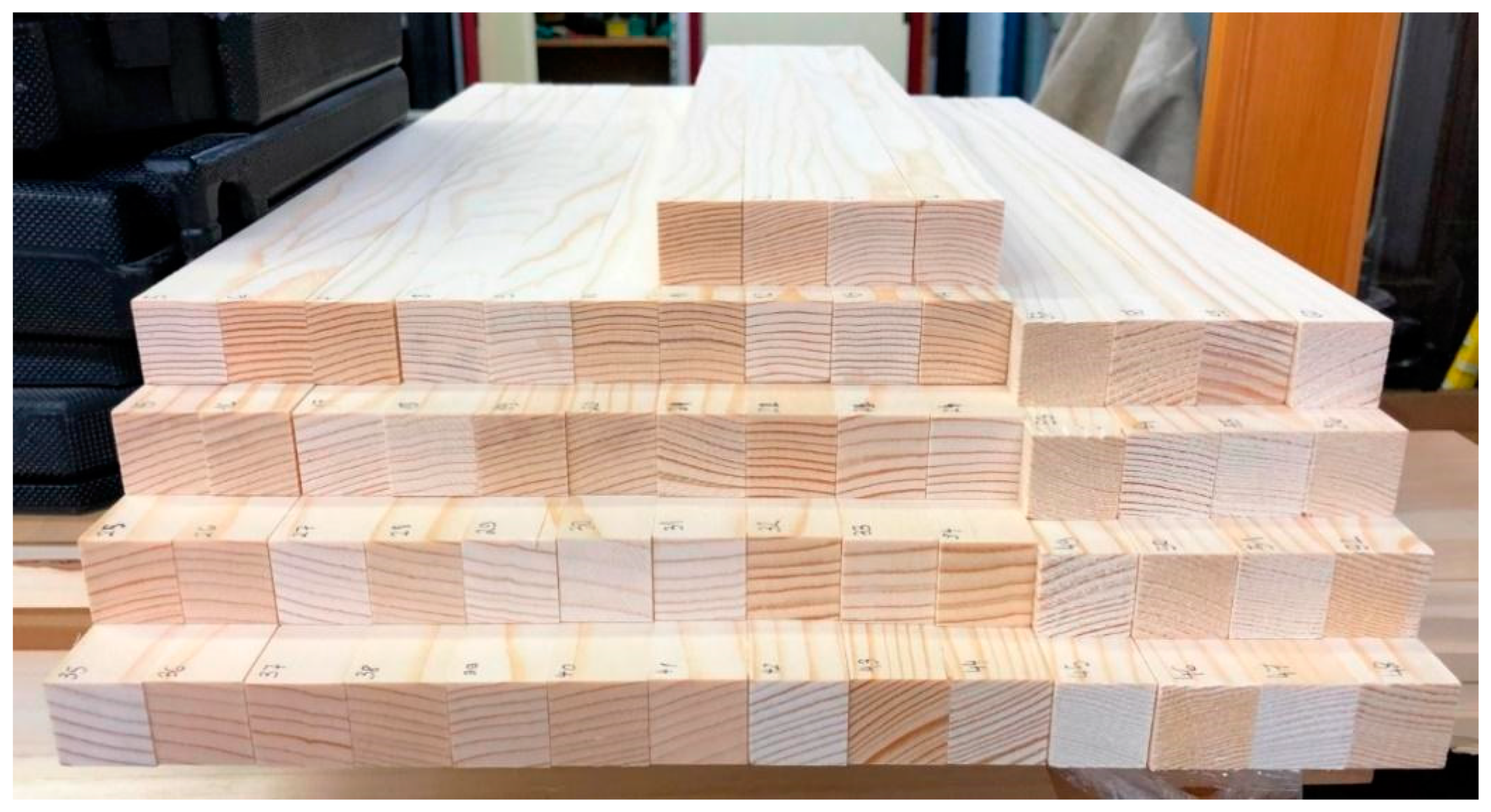
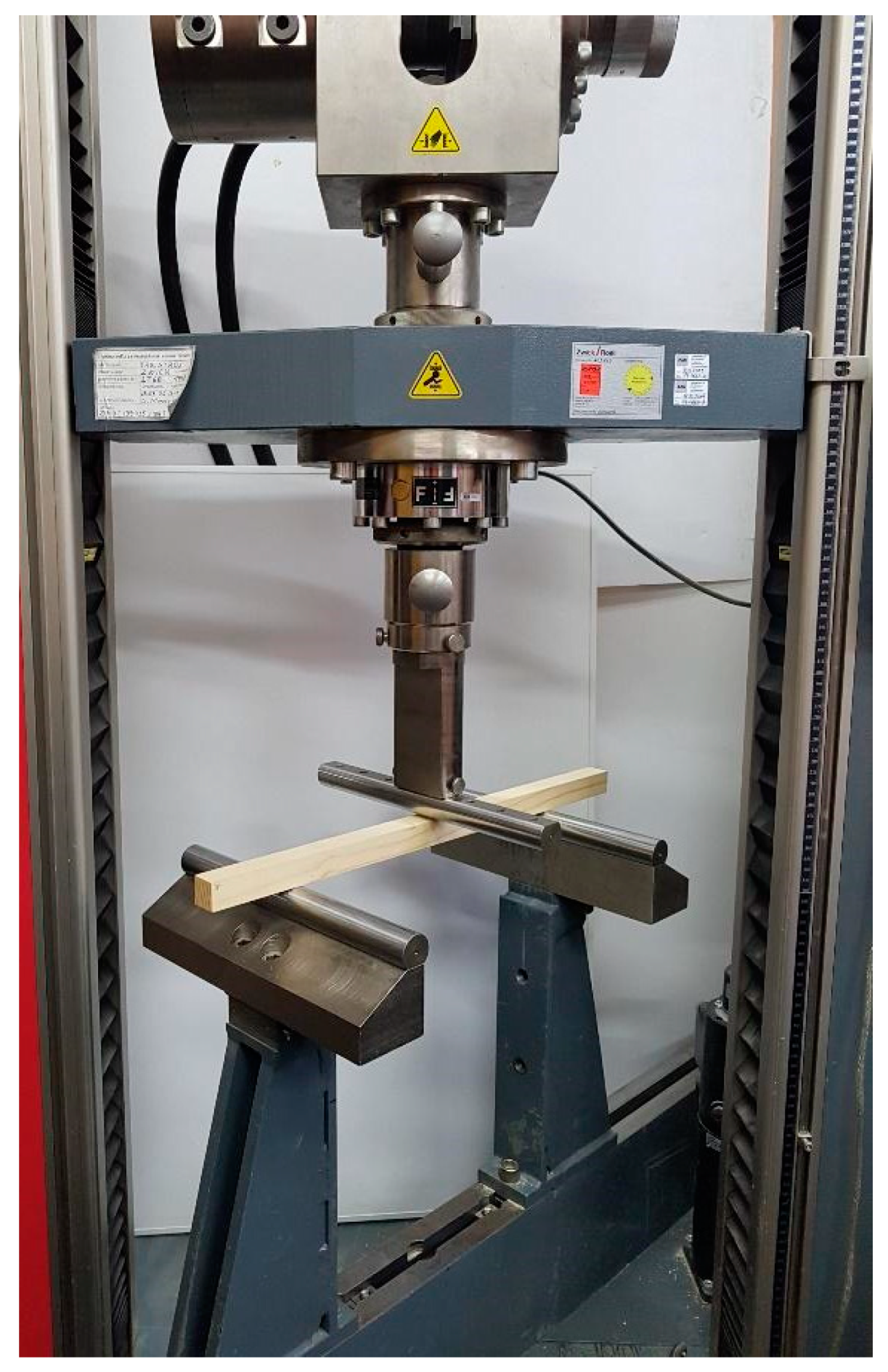
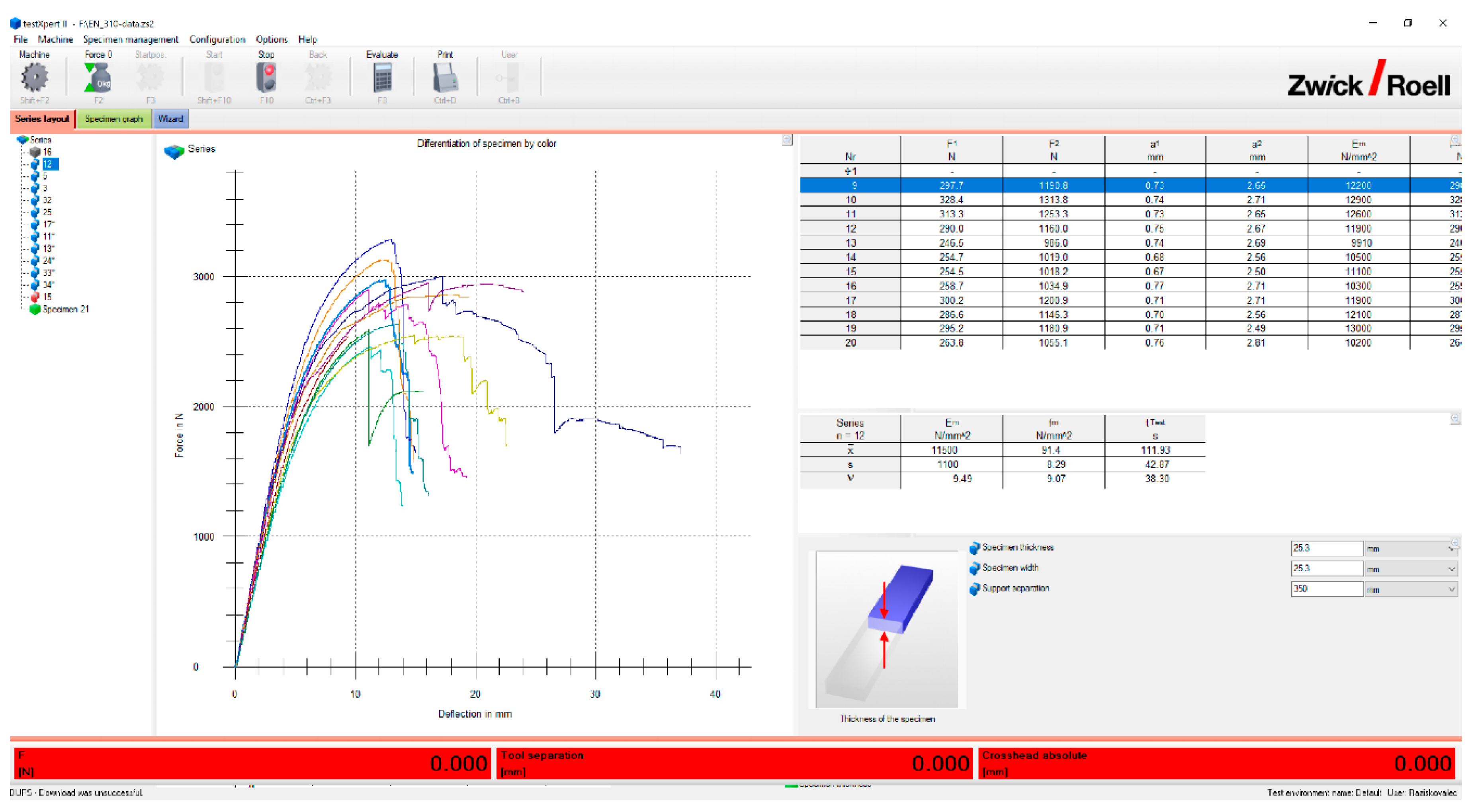
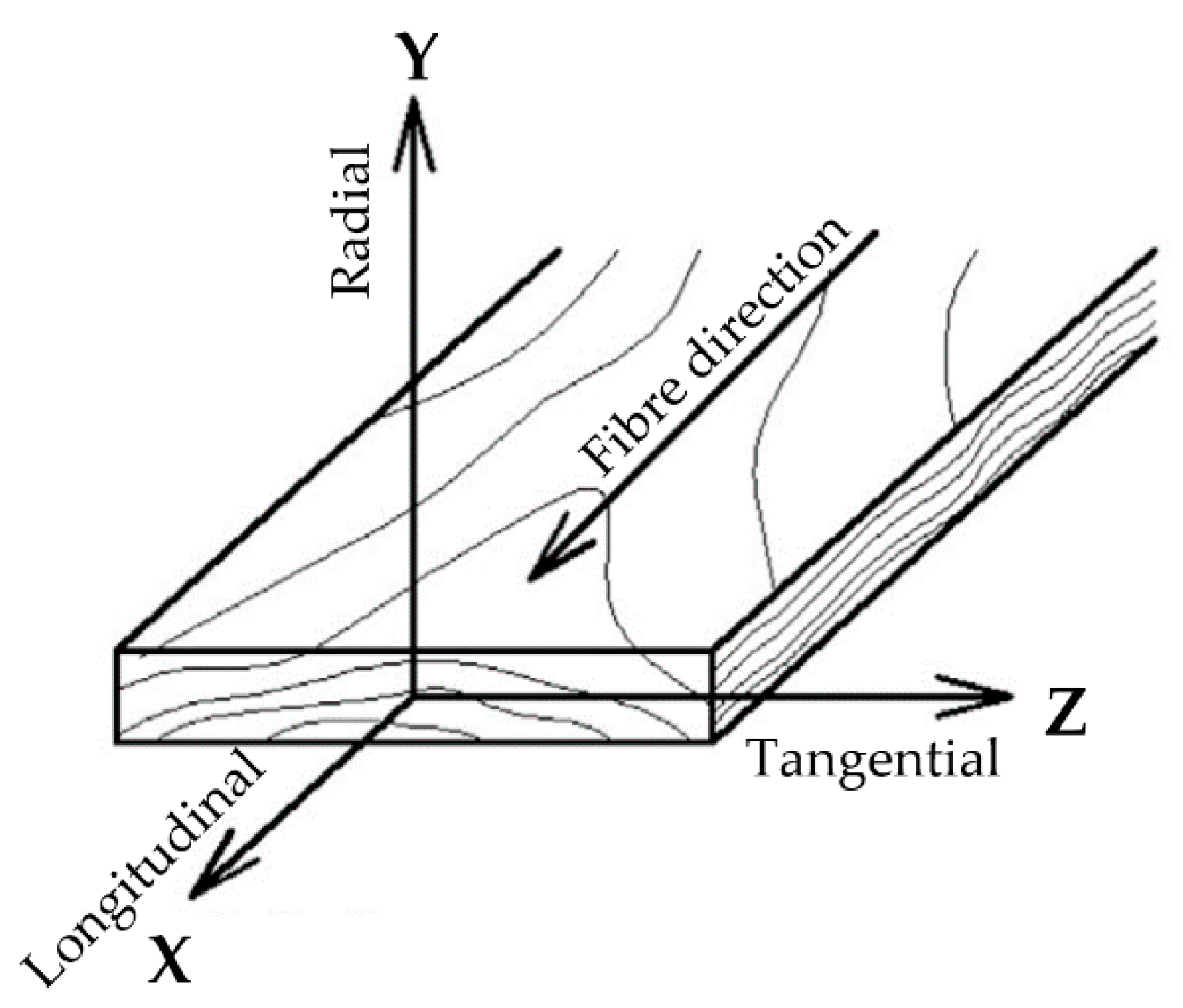

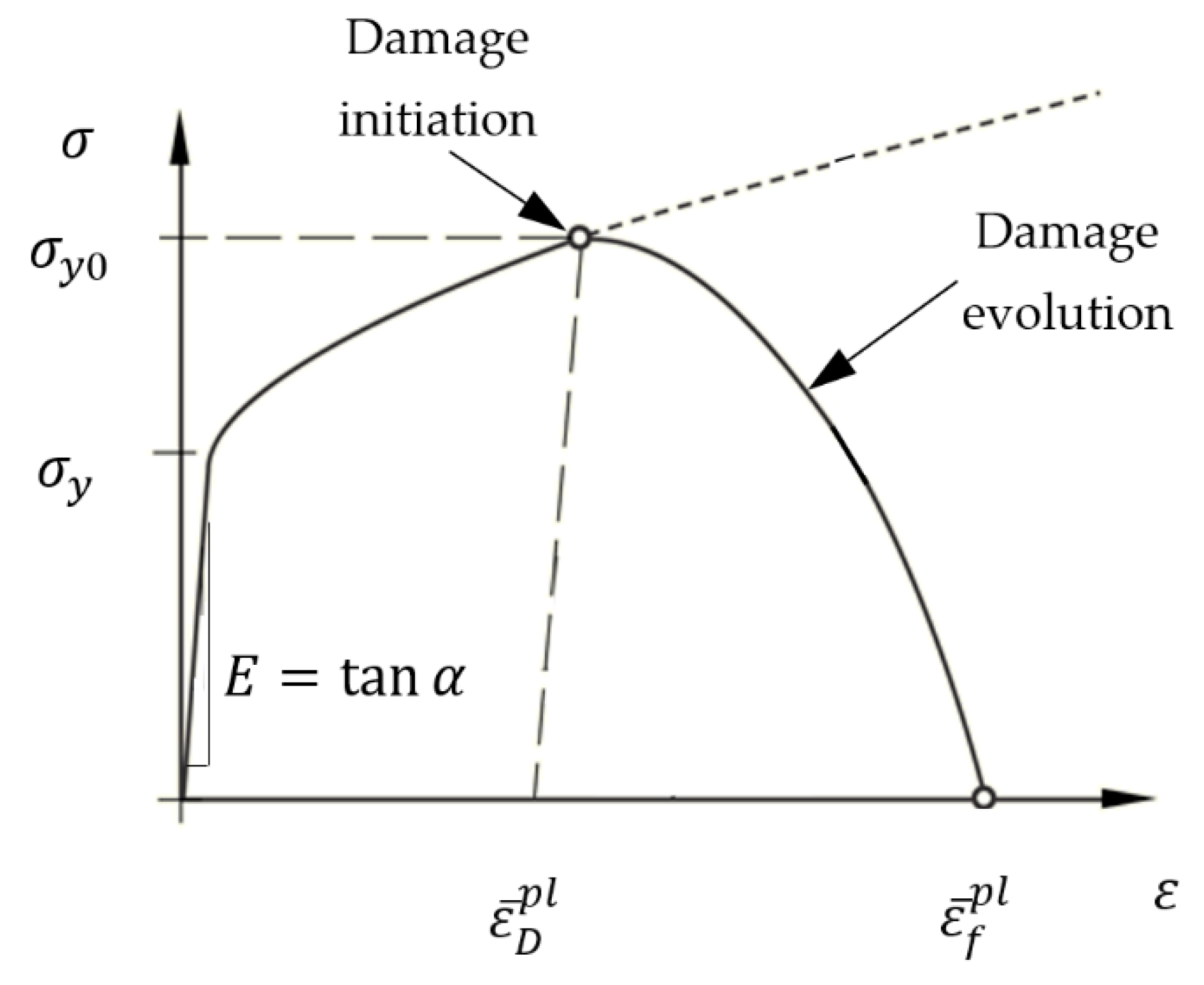
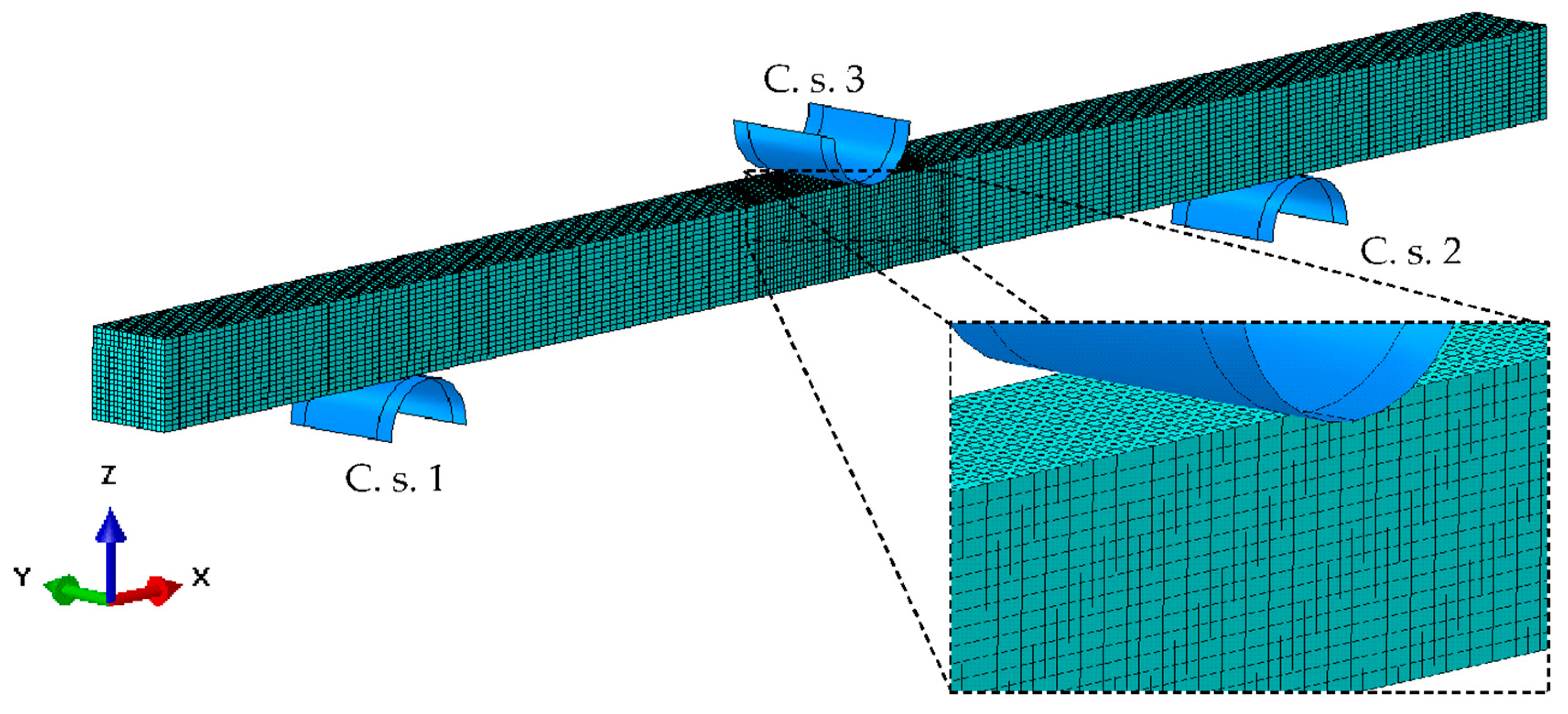
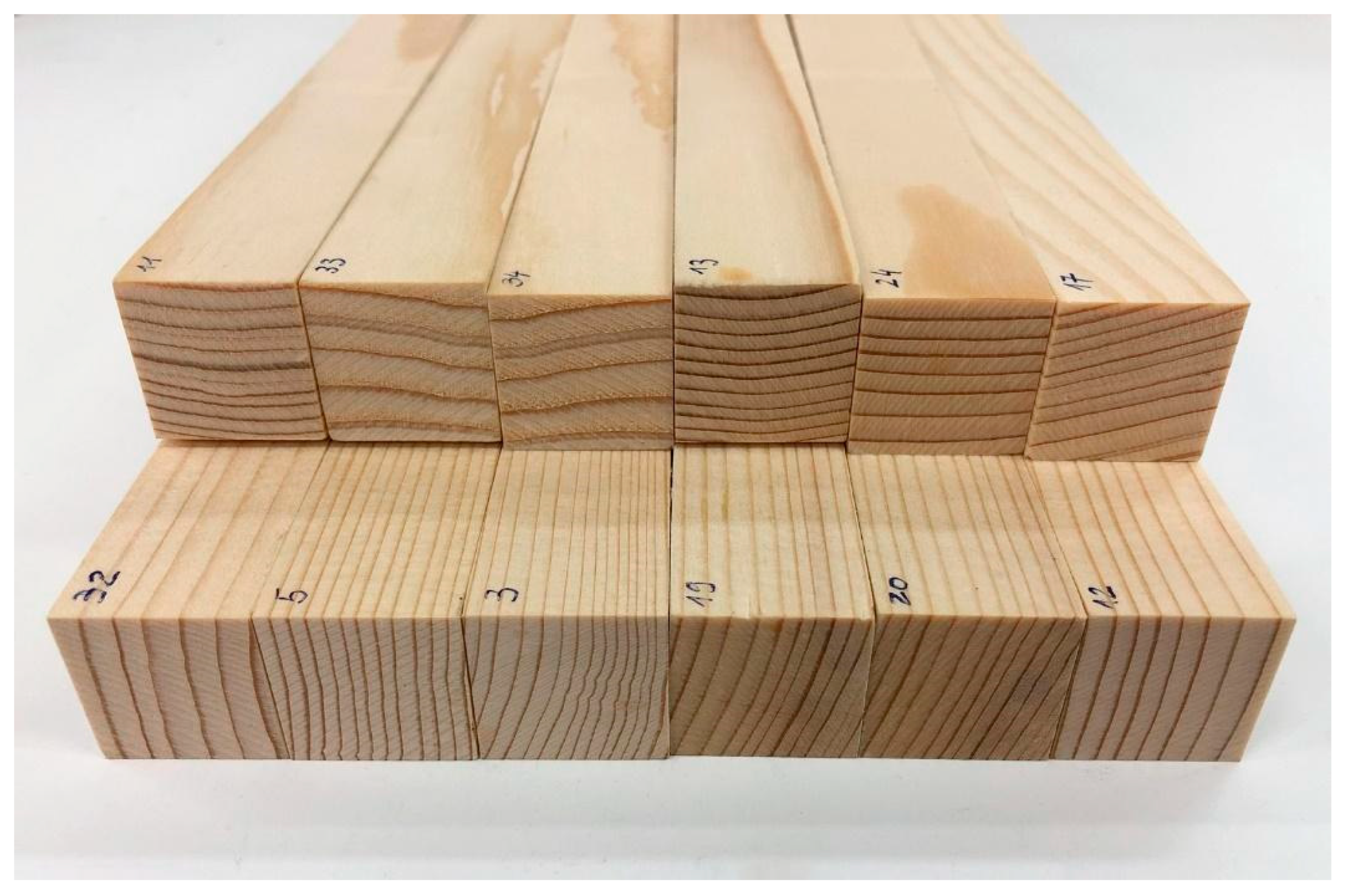

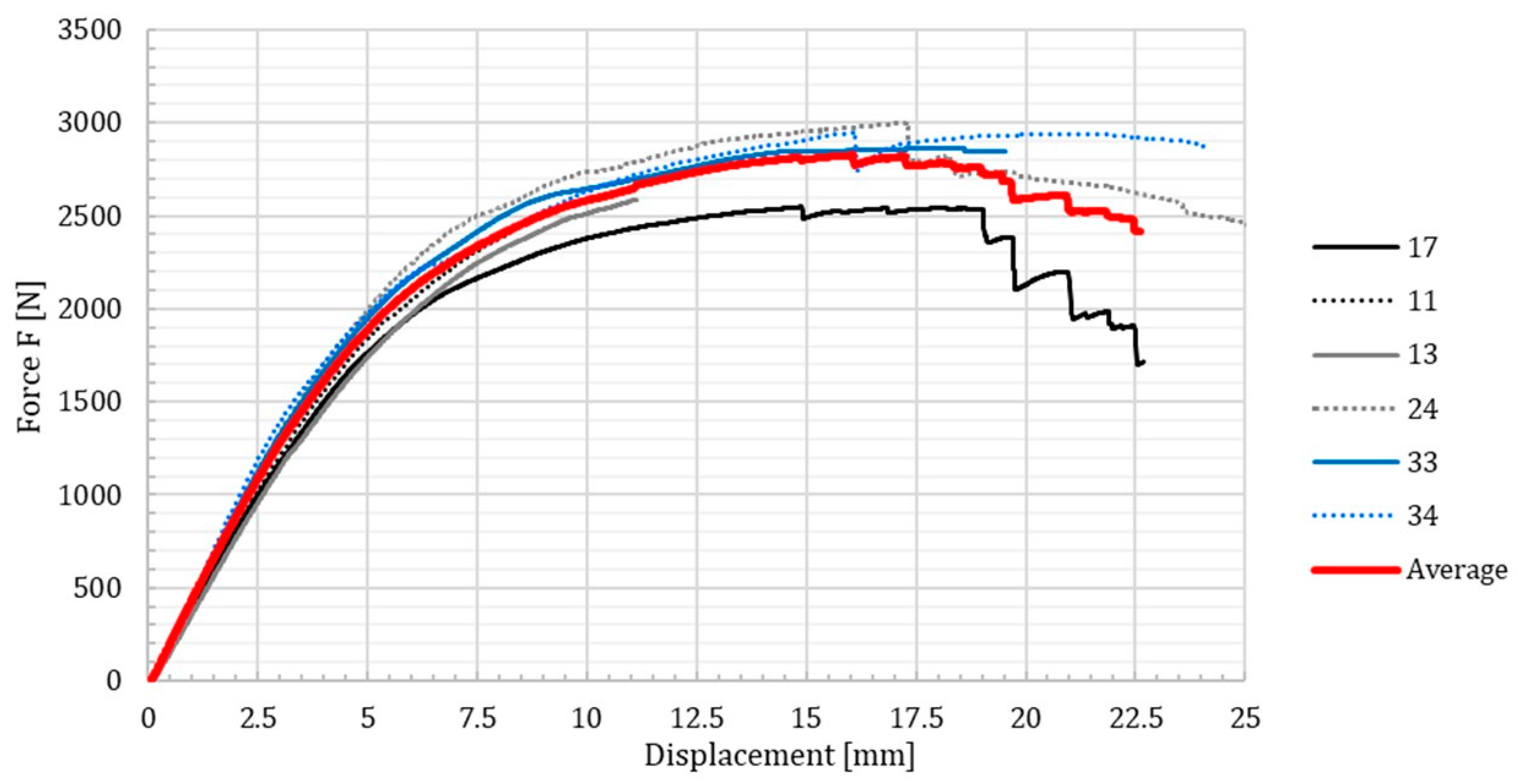

| Sample Nr. | Orient. | Mass (m) (g) | Length (L) (mm) | Width (b) (mm) | Height (h) (mm) | Density (ρ) (g/cm3) | Force (F) (kN) | MOE (E) (GPa) | Strength (σ) (MPa) |
|---|---|---|---|---|---|---|---|---|---|
| 32 | Tang. | 175.00 | 549.0 | 25.2 | 25.3 | 0.500 | 2.90 | 11.67 | 90.61 |
| 5 | Tang. | 173.99 | 549.0 | 25.4 | 25.4 | 0.491 | 3.28 | 12.63 | 101.01 |
| 3 | Tang. | 172.18 | 549.0 | 25.3 | 25.4 | 0.488 | 3.13 | 12.35 | 96.75 |
| 19 | Tang. | 163.79 | 549.0 | 25.2 | 25.2 | 0.470 | 3.04 | 11.19 | 95.43 |
| 20 | Tang. | 163.94 | 549.0 | 25.3 | 25.3 | 0.467 | 3.00 | 10.96 | 94.13 |
| 12 | Tang. | 161.78 | 549.0 | 25.3 | 25.3 | 0.460 | 2.98 | 11.92 | 92.65 |
| Sample Nr. | Orient. | Mass (m) (g) | Length (L) (mm) | Width (b) (mm) | Height (h) (mm) | Density (ρ) (g/cm3) | Force (F) (kN) | MOE (E) (GPa) | Strength (σ) (MPa) |
|---|---|---|---|---|---|---|---|---|---|
| 11 | Radial | 174.22 | 549.0 | 25.3 | 25.2 | 0.498 | 2.55 | 10.83 | 79.85 |
| 33 | Radial | 171.99 | 549.0 | 25.3 | 25.3 | 0.489 | 2.87 | 11.88 | 89.19 |
| 34 | Radial | 171.09 | 549.0 | 25.3 | 25.4 | 0.485 | 2.95 | 12.73 | 91.52 |
| 13 | Radial | 164.45 | 549.0 | 25.4 | 25.4 | 0.464 | 2.59 | 10.07 | 79.57 |
| 24 | Radial | 163.65 | 549.0 | 25.2 | 25.5 | 0.464 | 3.00 | 11.63 | 93.44 |
| 17 | Radial | 160.29 | 549.0 | 25.3 | 25.4 | 0.454 | 2.55 | 10.32 | 78.66 |
© 2019 by the authors. Licensee MDPI, Basel, Switzerland. This article is an open access article distributed under the terms and conditions of the Creative Commons Attribution (CC BY) license (http://creativecommons.org/licenses/by/4.0/).
Share and Cite
Fajdiga, G.; Rajh, D.; Nečemer, B.; Glodež, S.; Šraml, M. Experimental and Numerical Determination of the Mechanical Properties of Spruce Wood. Forests 2019, 10, 1140. https://doi.org/10.3390/f10121140
Fajdiga G, Rajh D, Nečemer B, Glodež S, Šraml M. Experimental and Numerical Determination of the Mechanical Properties of Spruce Wood. Forests. 2019; 10(12):1140. https://doi.org/10.3390/f10121140
Chicago/Turabian StyleFajdiga, Gorazd, Denis Rajh, Branko Nečemer, Srečko Glodež, and Matjaž Šraml. 2019. "Experimental and Numerical Determination of the Mechanical Properties of Spruce Wood" Forests 10, no. 12: 1140. https://doi.org/10.3390/f10121140
APA StyleFajdiga, G., Rajh, D., Nečemer, B., Glodež, S., & Šraml, M. (2019). Experimental and Numerical Determination of the Mechanical Properties of Spruce Wood. Forests, 10(12), 1140. https://doi.org/10.3390/f10121140






